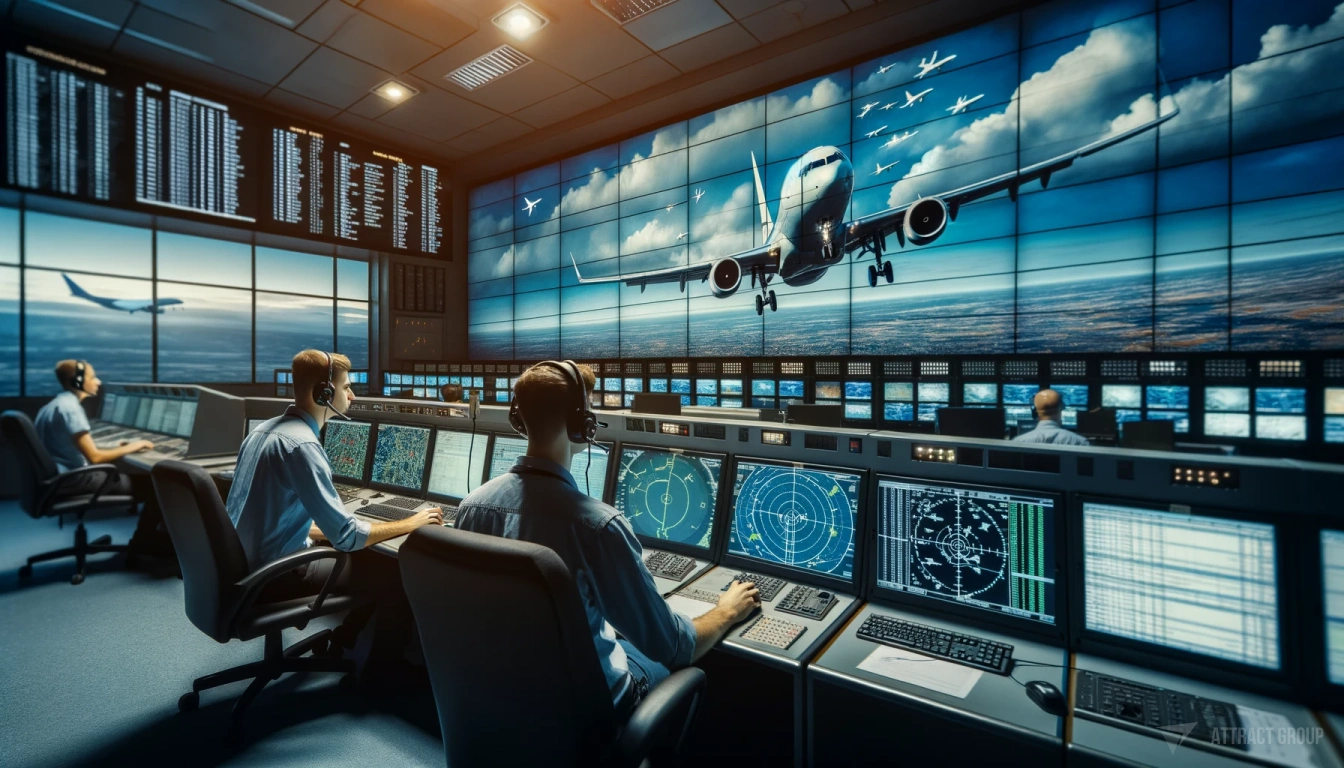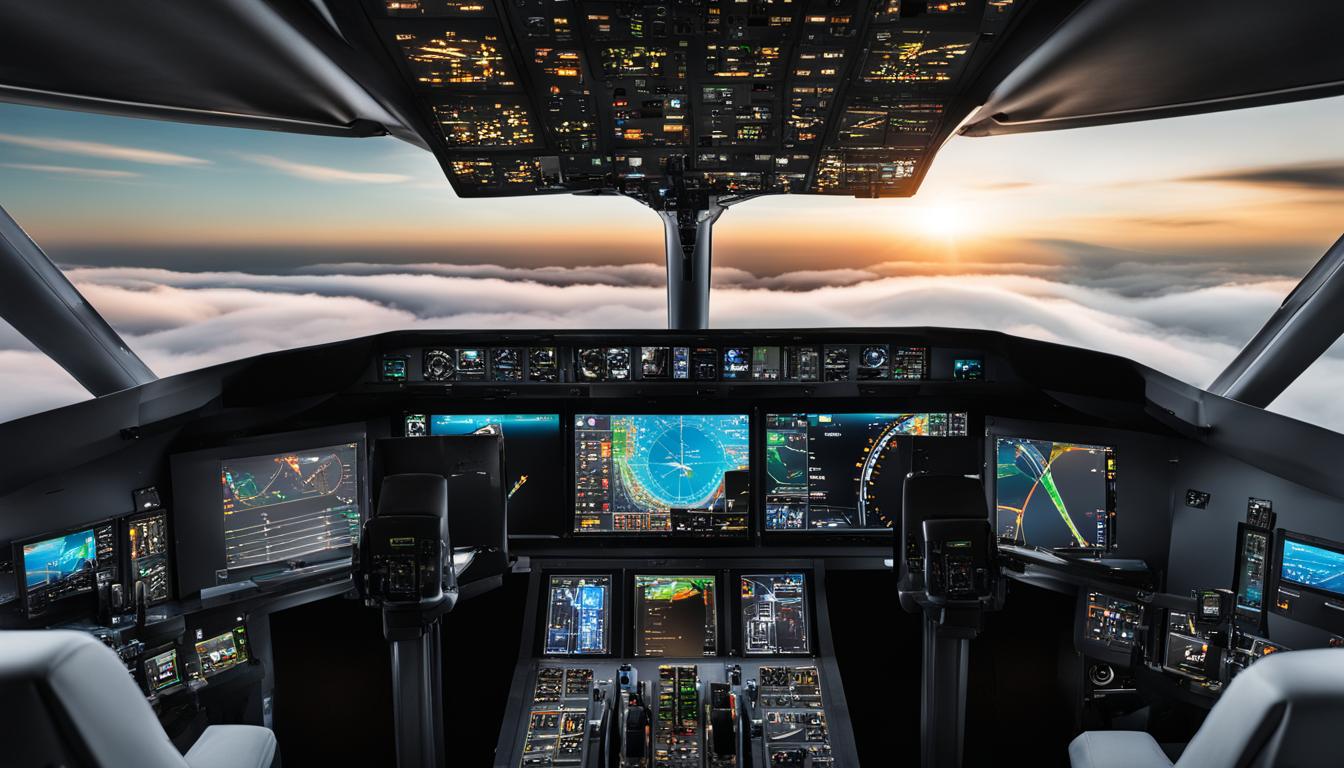Exploring Airplane ERP Future Trends: A Professional Insight
 2 January 2024
2 January 2024? Listen to the Summary of this article in Audio
The aviation landscape is undergoing a radical digital transformation, reshaping the scope of airplane ERP future trends. As the Airline industry technology evolves at a breakneck pace, so too does the necessity for advanced aviation ERP solutions. Today’s airline companies are not just grappling with the complexities of efficient scheduling and maintenance; they are engaging with complex software systems that require incessant innovation to maintain a competitive edge. The result is a technological revolution that is permeating all facets of airline management, from intelligent aircraft management software that underpins the seamless execution of operations and customer service to systems capable of handling elaborate data tasks with unprecedented accuracy.
These ERP systems are not merely operational tools; they are strategic instruments that are transforming the industry by introducing efficient ways to manage a myriad of functions, including airline reservations, operation, maintenance, and customer service. Integrating these multifaceted operations means tapping into the future’s digital potential, creating an infrastructure that supports advanced data management, and intertwining integrative capacities to ensure a responsive and resilient airline operating environment.
Key Takeaways
- The advent of digital transformation is crafting the airplane ERP future trends.
- Aviation ERP solutions are pivotal for adapting to technological advancements in the airline industry.
- Modern ERP systems seamlessly manage airline reservations, operations, maintenance, and customer service.
- Integration and advanced data management are essential features of current aircraft management software.
- Airline industry technology is evolving to meet the rising demands of efficiency and data accuracy.
- ERP systems excel not just in operation but in shaping strategic industry transformations.
Meet with our experts to discuss optimizing your airline operations and data systems.
The Growth Trajectory of the Business Aviation Market
The business aviation market is on an upward swing, with powerful growth indicators suggesting an industry on the cusp of monumental expansion. Evidenced by meticulous research and market analysis, the global Business Aircraft Market size is forecasted to soar to an impressive USD 1.2 trillion by 2025, which solidifies the sector’s pivotal role in modern global transportation. A fusion of increased air travel demand from businesses, coupled with the personal travel aspirations of individuals, is catalyzing this surge. High net worth individuals and corporate entities alike are in relentless pursuit of efficient, time-saving travel options, thereby injecting vigor into the market’s growth.

Reflecting on regional development, Asia-Pacific is set to outshine in growth metrics, with China and India poised as the forerunners promulgating unprecedented industry escalation. Meanwhile, the North American hemisphere continues to assert its dominance in the realm of aircraft sales. An analysis of market segmentation profoundly highlights the large cabin sector, which now commandeers over half of the total market share. Such trends not only chronicle the growth story but also underscore the evolving preference for space and luxury in the skies.
“The ascent in business aviation is not merely about numbers; it’s about how businesses and individuals view air travel as an indispensable component of their growth strategy,” – Riya Rajpoot, Senior Researcher at UnivDatos Market Insights.
As we witness this colossal growth, aircraft management software and aerospace ERP systems stand at the forefront of enabling and sustaining this surge. These sophisticated systems permit airlines to transcend traditional boundaries, providing an innovative, data-driven framework for operations management. Stewarding essentials like flight scheduling, passenger experience, and fleet maintenance, they are indispensable in piloting the industry towards a future gilded with efficiency and precision.
Let’s pivot to a data table that elucidates the compelling numerical testimony of the business aviation market’s triumph:
| Segment | Market Share | Growth Projection |
|---|---|---|
| Global Business Aircraft Market Size by 2025 | N/A | USD 1.2 trillion |
| Asia-Pacific Regional Growth | Leading Growth | Highest CAGR |
| North American Aircraft Sales | Dominant Force | Majority Share |
| Large Cabin Segment Market Share | >50% | Steady Increase |
To encapsulate, the business aviation market emerges as a robust and dynamic sphere, with the potential to redefine transportation paradigms. Nurtured by the steady hands of aircraft management software and bolstered by the foundational strength of aerospace ERP systems, this market’s trajectory is not only promising but also pivotal in heralding a new era of business travel.
Driving Factors Behind the Increasing Demand for Air Travel
The aviation industry is currently experiencing a significant uptrend in growth, primarily driven by the increasing demand for air travel. This surge is a multifaceted phenomenon, propelled by several key factors that have reshaped consumer behavior and business operations, leading to heightened personal travel frequency and an evolved business needs landscape.
Business Needs and Personal Travel Frequency
On the business front, executives and professionals are traveling more than ever. The globalization of the economy has necessitated frequent travel to maintain and establish international relations, spurring an increasing demand for air travel. Corporations are recognizing that face-to-face interactions foster stronger partnerships in a digital world, thus investing in travel as an essential aspect of their operations.

On the individual level, a burgeoning middle class with disposable incomes and a penchant for global exploration has led to a surge in personal travel. The modern leisure traveler seeks experiences across continents, facilitated by affordable and accessible airfare. Consequently, airlines are responding to this personal travel frequency by expanding networks and increasing flight options.
Technological Innovations Promoting Travel Ease
Technological progress in the aviation sector has served as a catalyst for this growth. Aviation industry advancements have introduced sophisticated Aviation ERP solutions, enhancing operational efficiencies, reducing costs, and improving the overall traveler experience. As a result, air travel has become more streamlined and convenient than ever before.
From online check-ins to real-time luggage tracking, technological innovations in aviation have revolutionized the way people fly. These advancements extend beyond customer-facing features to behind-the-scenes developments that ensure safety, sustainability, and efficiency. Modern airplanes are being equipped with cutting-edge propulsion systems, and the advent of autonomous systems is anticipated to redefine the role of human oversight in flight operations.
As we look to the future trends in the airplane industry, it is clear that these digital and technological strides will continue to propel the demand for air travel. Diving deeper into some of these technological innovations, here is an illustrated table that highlights notable advancements:
| Technological Innovation | Impact on Aviation |
|---|---|
| Electric and Hybrid-Electric Propulsion | Reducing emissions and operating costs, fostering sustainable aviation practices |
| Autonomous Flight Systems | Enhancing safety and operational efficiencies by reducing the potential for human error |
| Advanced Aircraft Materials | Improving aircraft performance and durability while allowing for lighter, more fuel-efficient designs |
The increased demand for air travel is sustained by a complex interplay between growing business needs, escalating personal travel frequency, and progressive technological innovations, all abetted by the sophisticated management capabilities of Aviation ERP solutions. This convergence of factors promises to drive the aviation market forward, revealing exciting future trends in the airplane industry with each passing year.
The Rise of Sustainable Practices in Aviation ERP
As the aviation industry strides into a new era focused on environmental stewardship, sustainable aviation practices are becoming a primary concern for businesses and consumers alike. The integration of emerging technologies in aviation within Aviation ERP solutions is critical to advancing this green movement. One of the most promising developments is the incorporation of electric and hybrid-electric propulsion systems into aircraft design. By offering notable reductions in emissions and operating costs, these innovations are reshaping the foundation of eco-friendly aviation.

Sustainability is not limited to fuel and emissions, however; it also pertains to the optimization of flight routes and the overall aviation value chain, including maintenance, materials procurement, and end-of-life aircraft management. Aviation ERP solutions are at the vanguard of this change, collecting and analyzing data to enhance environmental performance across the board. Below is a detailed examination of the sectors within the aviation industry that are being transformed by sustainable practices facilitated by sophisticated ERP solutions.
| Sector | Sustainable Impact | ERP Role |
|---|---|---|
| Propulsion Systems | Adoption of electric and hybrid technologies reducing carbon footprint | Regulating energy usage and maintenance scheduling |
| Flight Route Optimization | Minimizing fuel consumption and emissions during flights | Analyzing flight data to optimize routes and improve operations |
| Materials Procurement | Sourcing eco-friendly materials for aircraft construction | Tracking and managing sustainable suppliers and materials |
| End-of-Life Management | Promoting recycling and reducing waste in aircraft decommissioning | Facilitating the decommissioning process and parts reuse or recycling |
One of the key figures leading the charge towards a greener future in aviation is the utilization of alternative fuels. Bolstering the electric revolution, biofuels and synthetic fuels present viable options that ERP systems can manage and track, ensuring sustainable sourcing and consumption.
“The push for a greener aviation sector is not optional, but a necessity in our global fight against climate change. With the help of leading-edge Aviation ERP solutions, we are witnessing a sea change in how airlines operate, contribute to a healthier planet, and create value for shareholders and society.”
- Integration of sustainable fuel alternatives into supply chain management
- Detailed emissions tracking and reporting functionality
- Improvement of resource planning and reduction of environmental impact
Emerging technologies in aviation, such as the use of advanced analytics and AI, enable ERP systems to forecast and plan for more sustainable operations, creating a ripple effect that benefits all stakeholders. By embracing ERP systems designed with sustainability in mind, airlines ensure compliance with environmental regulations, enhance their brand image, and align with the values of eco-conscious passengers.
As we progress into the future, the harmonization of ERP systems with sustainable practices is becoming the benchmark for aviation excellence. This strategic confluence of technology and ecological responsibility will undeniably be a significant driving force in shaping the aerospace industry of tomorrow.
Technological Advancements Shaping Aviation ERP Solutions
The relentless march of progress within the airline industry technology has instigated a paradigm shift with Aviation ERP solutions placed at the intersection of innovation and functionality. What were once futuristic visions are now tangible realities, with electric hybrid-electric propulsion and autonomous systems offering greener, safer, and more efficient alternatives to aviation’s status quo.
Electric and Hybrid-Electric Propulsion Systems
In an industry as fossil-fuel reliant as aviation, the shift towards electric hybrid-electric propulsion systems heralds a significant milestone. It represents an eco-conscious pivot, aiming to decrease emissions dramatically while also reducing operational costs. ERP software for airlines plays a crucial role, integrating these new propulsion technologies into existing fleet management frameworks, optimizing energy utilization, and redefining maintenance logistics.
| Propulsion Technology | Impact on Fleet Management | ERP Adjustments Needed |
|---|---|---|
| Electric Hybrid-Electric Propulsion | Lower emissions, Reduced operating costs | Energy consumption tracking, Maintenance scheduling alterations |
| Fully Electric Propulsion | Zero emissions, Dependency on charging infrastructure | Charging station management, Rerouting to accommodate charging times |
Autonomous Systems and Their Impact on ERP
The integration of autonomous systems into the navigation and operation of aircraft presents a breakthrough in enhancing safety and operational efficiency. These advanced technologies, leveraging machine learning and AI, promise to streamline countless processes monitored by Aviation ERP solutions. From automatically scheduling flights to conducting maintenance checks, autonomous systems offer a proactive approach to airline management, necessitating ERP systems evolving to accommodate increasingly self-governing frameworks.
- Maintenance and fault prediction analytics
- Automated flight scheduling and route optimization
- Pilot-assistive technologies for enhanced safety
The Role of Advanced Materials in Aircraft Design
The advent of advanced materials in aircraft design is radically altering aviation’s construction and maintenance paradigms. Use of lighter, stronger composites and innovative alloys promise greater fuel efficiency and the need for less frequent repairs. Merging these materials into aircraft design necessitates a retooling of how aviation ERP solutions manage inventory, track lifecycles, and log wear and tear. The ERP systems are pivotal for leveraging these emerging technologies in aviation to their fullest potential.
Utilizing advanced materials within the design process not only conserves resources but also enhances aircraft performance, a quintessential example of how innovation and sustainability can go hand-in-hand in the aerospace sector.
The evolution of Airline industry technology signifies an era where Aviation industry technology is equally predicated on advancement and adaptability. The result is a complex landscape wherein Aviation ERP solutions must uphold a delicate balance—incorporating the latest in propulsion and materials technology while maintaining the reliability and safety that is paramount in the skies.

Enhancing Customer Experience Through Advanced ERP Features
The realm of commercial aviation is witnessing a digital renaissance, with Aviation ERP solutions pioneering a more nuanced and enriched travel journey. In today’s fast-paced world, customer expectations are sky-high, and airlines are tapping into the potential of ERP systems to deliver an enhanced customer experience. The advanced features of these systems are transforming how passengers interact with airlines before, during, and after their flights.
One of the most noticeable shifts in the customer experience comes from investment in in-flight connectivity. Airlines recognize the modern passenger’s need to stay online and are therefore ensuring that passengers have access to high-speed internet as they traverse the skies. This connectivity is not merely about browsing the internet or streaming videos; it’s a strategic touchpoint for airlines to engage with customers, provide real-time flight updates, offer personalized services, and gather valuable feedback.
Aside from the digital components, physical comforts are getting a boost, too. Improvements to in-flight entertainment systems and cabin amenities have become a central focus with the use of Aviation ERP solutions. These systems enable airlines to manage content updates, monitor system performance, and analyze usage data to refine entertainment offerings.

To further illustrate the impact of ERP features on customer satisfaction, consider the insights detailed in the following table:
| ERP Feature | Customer Satisfaction Impact |
|---|---|
| In-flight Connectivity | Allows passengers to stay online, boosting satisfaction by offering continuous access to personal and professional communications. |
| Enhanced In-flight Entertainment | Improves passenger engagement with a variety of entertainment options, tailored to preferences and flight duration. |
| Cabin Comfort Enhancements | Heightens the overall travel experience with better seating, lighting, and temperature control, leading to increased passenger comfort. |
| Personalized Services | Uses passenger data to offer personalized in-flight services such as meal preferences and loyalty rewards, building stronger customer relations. |
Moreover, airplane fleet management is made more efficient through ERP systems, ensuring that aircraft are optimally assigned, monitored, and maintained, thereby reducing the likelihood of cancellations or delays. As a result, passengers enjoy a more reliable and predictable travel experience, which significantly contributes to overall satisfaction and brand loyalty.
What’s more, ERP solutions facilitate seamless interactions across various touchpoints, such as ticket booking, check-in, baggage handling, and post-flight services. By integrating these functions, airline operations are made smoother, directly translating to a stress-free passenger experience.
- Integrated Ticketing Systems: Streamlines booking and check-in procedures, reducing wait times and frustration.
- Baggage Handling Transparency: Offers passengers real-time tracking of their luggage, providing peace of mind.
- Post-Flight Services: Speeds up feedback collection and response to customer concerns, enhancing post-travel customer care.
“The integration of ERP features into the aviation landscape is not just about technology; it’s about reimagining the passenger experience with every flight, making air travel more than transportation, but an experience in itself.”
As we move into the future, the focus on customer experience will continue to intensify, with airlines racing to outdo each other. The strategic leveraging of Aviation ERP solutions will play a definitive role in crafting experiences that resonate with passengers, fostering a sense of loyalty and preference for airlines that prioritize not just safe and efficient travel, but an ambient journey crafted around customer needs and desires.
Statistical Insights: Business Aviation Industry Growth Rates and Projections
Within the soaring realm of the business aviation landscape, remarkable growth trajectories are setting the pace for what’s anticipated to be a period of significant economic contribution and employment opportunities. The industry’s compound annual growth rates (CAGR) deliver a revealing look into the sector’s financial dynamics, hinting at the robust health of the business aviation market. Poised to burgeon with a CAGR of 4.72% from the year 2020 to 2025, the sector asserts its capability to be a prime mover in the broader economic context.
Delving deeper into the forecast period’s projections, the industry not only promises to elevate market valuation astonishingly – with predictions to hit a remarkable USD 40.21 billion by the year 2030 – but also to play an instrumental role in job creation. By the year 2025, over 1.5 million job positions are expected to manifest within the industry’s various segments, underscoring a considerable boon to the global economy. Moreover, beyond mere employment figures, the business aviation sector is set to make an impressive impression on the Gross Domestic Product (GDP), projected to contribute in excess of USD 150 billion.
Amidst these compelling statistics, the intrinsic role of aircraft management software becomes ever-clearer. As a vital cog in the industry, such sophisticated tools and systems underpin these growth rates, ensuring seamless operations and contributing to the aviation industry advancements observed globally. Their proliferation and optimization are fundamental avenues through which the industry secures its ascent, blending operational excellence with strategic foresight.
| Indicator | Value | Remark |
|---|---|---|
| Compound Annual Growth Rate (2020-2025) | 4.72% | Reflecting a steady growth of the industry |
| Anticipated Market Value by 2030 | USD 40.21 billion | An indicator of the sector’s economic significance |
| Projected Job Creation by 2025 | Over 1.5 million jobs | Significant impact on employment figures |
| Contribution to GDP by 2025 | More than USD 150 billion | A robust indicator of the industry’s economic footprint |
As the business aviation industry growth rates continue to scale new heights, so too does the necessity for adopting the latest in aircraft management software. These advancements are pivotal to propelling the sector forward, harnessing analytics and data management to streamline flight operations, enhance customer engagements, and ultimately drive profitability. – UnivDatos Market Insights
- Integrated Data Analytics: Facilitating real-time decision-making and operational streamlining.
- Customer Relationship Management (CRM): Leveraging software to curate bespoke customer experiences and loyalty programs.
- Efficient Route Planning: Utilizing software for optimizing flight paths, saving time and fuel.
The confluence of these factors unfurls a future brimming with opportunities – one where aircraft management software stands as a sentinel guiding the industry through the corridors of innovation and profitability.
Optimizing Operational Efficiency with Aerospace ERP Systems
The aerospace industry stands on the brink of a new era, one where Aerospace ERP systems are instrumental in engendering a monumental leap toward operational efficiency. In a landscape characterized by its complexity and demand for precision, ERP systems offer a beacon of integration, allowing for an effortless fusion of manufacturing processes, supply chain management, quality assurance, and compliance tracking.

The ability of ERP systems to channel real-time data analytics is revolutionary, providing aerospace businesses with the astuteness required for informed and prompt decision-making—a determinative factor in the global industry’s expansion. Let us delve into various sectors within aerospace operations that are benefiting from the implementation of ERP systems:
| Operational Segment | ERP Impact |
|---|---|
| Supply Chain Management | Integration of global supplier networks, forecasting, and inventory optimization |
| Production Scheduling | Automated and efficient scheduling, reducing turnaround times |
| Quality Assurance | Continuous monitoring and compliance adherence, reducing defects and rework |
| Regulatory and Compliance Tracking | Ensures all operations meet industry standards and regulations, mitigating risk |
| Maintenance Management | Proactive maintenance planning, in-line with real-time operations data |
| Customer Relationship Management | Improved customer engagement and service through data-driven insights |
The robustness of ERP systems within the aerospace sector is evident in their capacity to streamline otherwise siloed operations, thereby eliminating redundancies and maximizing resource utilization. This holistic approach encapsulated in Aerospace ERP systems not only fortifies operational efficiency but also kindles strategic advancements pivotal for the perpetuation of industry leadership.
In the realm of aerospace, where precision is the lifeblood of all operations, ERP systems have become the fulcrum of operational integrity and developmental innovation.
- Real-time analytics empower agile adjustments in manufacturing processes
- Compliance modules within ERP systems ensure stringent adherence to international standards
- Converged data platforms centralize information, enhancing collaborative innovation
The ascent of ERP systems in governing the multifarious strings of aerospace manufacturing marks the dawn of a new epoch in which airplane ERP future trends are increasingly shaped by technological prowess and an unwavering pursuit of excellence. Indeed, as the digital transformation of aerospace firms transcends mere adoption and interfaces with its long-term strategic roadmaps, the potential for scaling new heights in operational efficiency and industry growth becomes infinite.
Our team can implement a customized ERP system to optimize and connect your business operations.
Custom Software Development for Tailored Airplane ERP Solutions
In the aerospace industry, operational excellence hinges on the precision with which every process and system function. One critical aspect of ensuring this precision is the utilization of Aviation ERP solutions that are intricately tailored to meet the unique needs of the sector. Recognizing this, companies often opt for custom software development to fine-tune their ERP systems, ensuring that they not only support complex aerospace operations but also drive innovation and efficiency.
Custom software development can infuse Aviation ERP systems with exceptional capabilities that are aligned perfectly with the nuanced processes of aircraft manufacturing. From facilitating real-time data analytics to managing the intricate supply chains seamlessly, these tailored airplane ERP solutions offer a competitive advantage.
Let’s explore the multifaceted benefits of custom-developed ERP systems:
- Adaptability to Rapid Technological Changes
- Enhanced Support for Compliance with Aviation Regulations
- Streamlined Manufacturing and Supply Chain Processes
- Robust Data Security Measures Tailored to Airline Operational Needs
With custom software development, aerospace companies can ensure their ERP systems are scalable, flexible, and future-ready. These bespoke systems allow for a high level of integration capability, critical for supporting the diverse technologies and applications required in airplane manufacturing and maintenance.

The following table illustrates typical ERP modules that are crucial for aerospace operations and how custom development enhances their functionality:
| ERP Module | Standard Function | Custom Development Enhancements |
|---|---|---|
| Supply Chain Management | Facilitates procurement and logistics operations | Integrates with real-time tracking systems for components and materials sourcing |
| Quality Control and Compliance | Monitors adherence to industry standards | Advanced analytics for predictive compliance and real-time corrective action |
| Production Planning | Schedules manufacturing tasks and resource allocation | Dynamically adjusts production schedules based on supply chain and operational data |
| Maintenance and Repair Operations | Tracks maintenance schedules and service histories | Custom workflow automation and IoT integration for predictive maintenance alerts |
| Human Resource Management | Manages employee data and payroll | Enhanced with aerospace-specific training modules and certification tracking |
Custom software development entrusts companies with the autonomy to dictate every aspect of their ERP solution, ensuring that it complements their specific workflows, industry niche, and strategic objectives. This not only leads to more streamlined operations but also equips manufacturers with the agility to pivot as market dynamics change.
“In an industry shaped by precision, customization in ERP solutions is not just a luxury—it is essential. As aerospace operations become more integrated and technology-driven, the role of custom-developed ERP systems will increasingly become a cornerstone for success.” – Vladimir Terekhov, CEO and Co-Founder
As the aviation sector continues to embrace digital transformation, the demand for custom software development geared towards tailored airplane ERP solutions is anticipated to scale in tandem. This focused and specialized approach to ERP will serve as the bedrock for aerospace companies aiming to achieve new operational heights and solidify their market presence in the complex, yet thrilling world of aviation.
Conclusion
As we navigate through the currents of change in the aviation sector, the adaptation and utilization of revolutionary airplane ERP future trends stand out as catalysts for transformation. The impact of these systems extends beyond mere operations, influencing the very framework of the airline industry technology. With advancements such as electric propulsion and autonomous flight systems, alongside ERP systems optimized for sustainable operations, the aviation industry is reshaping its future trajectory. Custom software development, sedulously tailored to the intricate demands of aviation, fortifies the industry’s capacity to streamline processes, comply with global regulations, and enhance customer service.
It is evident that aviation industry advancements are sculpting an ecosystem where efficiency is empowered by smart technology, integrating complex components into a cohesive and agile operation. Through innovative ERP solutions, businesses in this sector are now more equipped to compete in a dynamic, environmentally conscious marketplace. As the industry continues to grapple with the challenges imposed by digital transformation, the need for custom software development also burgeons, representing a critical avenue for achieving true operational excellence.
As we lift our gaze to the horizon, we see a future rich with possibility. One where the merging of sophisticated ERP software with cutting-edge technological innovations fundamentally alters how we perceive and engage with air travel. Airplane ERP future trends and the progressive adoption of airline industry technology are illuminating pathways towards a more sustainable, efficient, and customer-centric aviation landscape. It is this confluence of innovation, foresight, and adaptability that will continue to propel the aviation industry forward, setting new standards and soaring to greater heights.
Meet with our experts to discuss leveraging technology to enhance your airline operations.
FAQ
What are the current future trends in airplane ERP?
Airplane ERP future trends include the adoption of sustainable practices such as electric and hybrid-electric propulsion systems, integration of autonomous flight technologies, use of advanced materials for aircraft design, and customization of software solutions for enhanced operational efficiency and customer experiences.
How is the business aviation market projected to grow in the coming years?
The global business aviation market is expected to reach USD 1.2 trillion by 2025, driven by increased air travel demand and the need for efficient transportation solutions. The large cabin segments are seeing significant market share, indicating overall industry growth.
What are the main factors driving the increased demand for air travel?
Factors contributing to the growing demand for air travel include the higher frequency of air travel required by businesses and individuals, and technological innovations that provide convenience and efficiency in air transportation.
How are sustainable practices being integrated into aviation ERP?
Sustainable practices in aviation ERP include optimizing flight routes for fuel efficiency, incorporating electric and hybrid-electric propulsion systems to reduce emissions and operating costs, and emphasizing eco-friendly aircraft solutions across the aviation value chain.
How are technological advancements impacting aviation ERP solutions?
Technological advancements are reshaping aviation ERP through the development of electric and hybrid-electric propulsion systems, incorporation of autonomous flight technologies for operational efficiency, and integration of advanced materials that enhance efficiency and sustainability within aircraft designs.
In what ways can advanced ERP features enhance customer experience?
Advanced ERP features can improve customer experience by streamlining the reservation process, providing in-flight connectivity and entertainment systems, and enhancing cabin amenities to meet the evolving expectations of passengers.
What are the growth rates and projections for the business aviation industry?
The business aviation industry is expected to witness a compound annual growth rate of 4.72% from 2020 to 2025, generate over 1.5 million jobs, contribute more than USD 150 billion to GDP by 2025, and reach a market value of USD 40.21 billion by 2030.
How do aerospace ERP systems optimize operational efficiency?
Aerospace ERP systems enhance operational efficiency by offering integrated solutions that streamline manufacturing processes, supply chain management, compliance tracking, and provide real-time data analytics for informed decision-making.
Why is there a need for custom software development in airplane ERP solutions?
Custom software development is crucial for airplane ERP solutions to cater to the unique requirements of the aerospace sector, ensuring scalability, high precision, and integration capabilities necessary for aircraft manufacturers.
What transformative shifts are occurring in the airplane ERP landscape?
The airplane ERP landscape is undergoing a transformative shift with a focus on sustainability, operational efficiency, and customization, paving the way for a future aviation sector that is environmentally responsible, efficient, and customer-centric.









